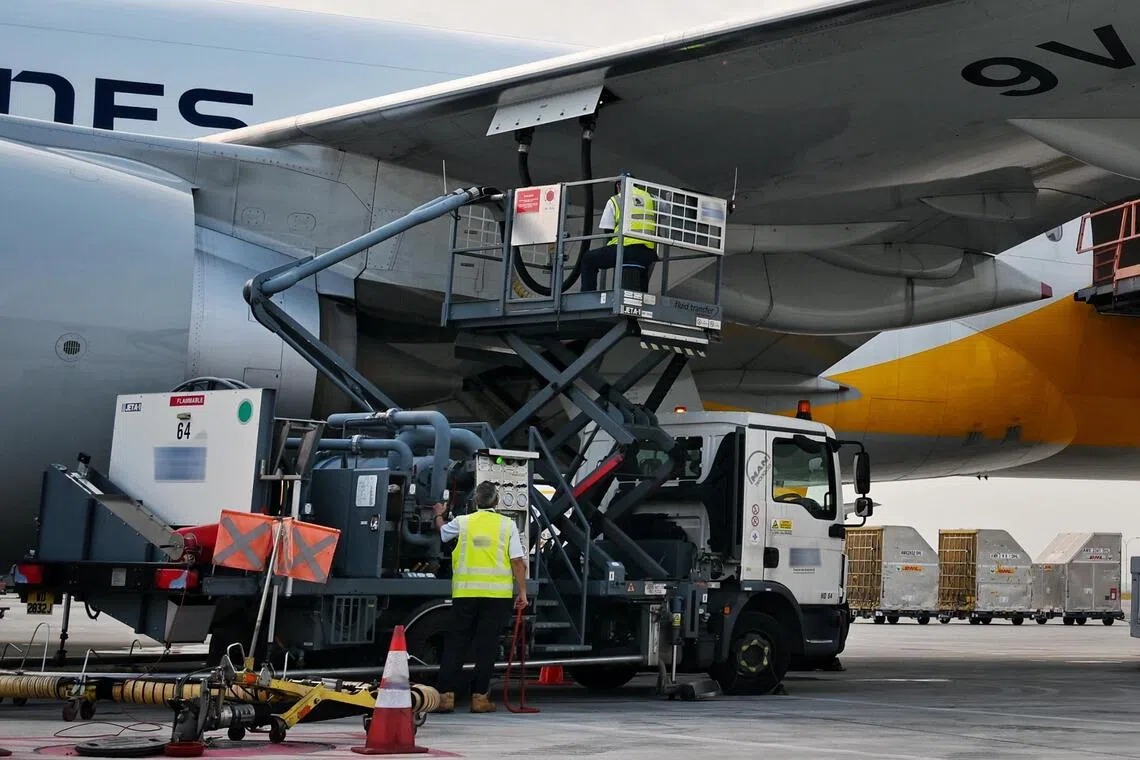S’pore forms company to buy green jet fuel; passenger levy amounts to be announced by end-2025
Sign up now: Get ST's newsletters delivered to your inbox

The Singapore Sustainable Aviation Fuel Company will use a levy collected from passengers to buy the green jet fuel.
ST PHOTO: KUA CHEE SIONG
Follow topic:
- Singapore created SAFCo to centrally buy sustainable aviation fuel using a levy on departing flights, starting in 2026.
- The aim is for 1% sustainable fuel use by 2026, rising to 3-5% by 2030, blending it with traditional jet fuel for existing aircraft.
- The fixed levy ensures cost stability and encourages production, helping Singapore meet emission targets, while maintaining competitiveness.
AI generated
SINGAPORE – A company has been set up to buy and manage a supply of sustainable aviation fuel for Singapore’s air hub, the Civil Aviation Authority of Singapore (CAAS) said on Oct 30.
The Singapore Sustainable Aviation Fuel Company (SAFCo) will use a levy collected from passengers to buy the green jet fuel, which will be blended with traditional aviation fuel and used to refuel planes at Changi and Seletar airports. This comes about two weeks after Parliament passed a Bill
The target is for such fuel to constitute 1 per cent of all jet fuel used at Changi and Seletar airports in 2026, with the goal raised to 3 per cent to 5 per cent by 2030. Sustainable aviation fuel is mostly made from waste materials, such as used cooking oil. Travellers flying out of Singapore will pay a sustainable aviation fuel levy from 2026, which SAFCo will use to buy the fuel needed to meet the target.
CAAS wholly owns SAFCo, with the authority’s director-general Han Kok Juan chairing SAFCo’s board. Ms Tan Seow Hui, a veteran in the energy and aviation industries, has been appointed chief executive of SAFCo. She is the former global head of marketing and sustainability at Shell’s low-carbon solutions division.
Early CAAS estimates suggested that economy-class passengers may incur a $3 levy for short-haul flights, $6 for medium-haul flights and $16 for long-haul flights. Short-haul flights include routes to places such as Bangkok, medium haul to destinations like Tokyo, and long haul to cities such as London.
More details about the levy, including the confirmed amounts, will be announced by end-2025, CAAS said. The levy will be calculated based on the distance travelled and class of travel, with business and first class passengers paying more.
Sustainable aviation fuel has been deemed the most practical way to decarbonise the aviation industry, as it can be blended with jet fuel and used on existing aircraft and refuelling infrastructure without costly modifications.
At a press conference on Oct 30, Mr Han and Ms Tan said SAFCo will centrally procure the fuel based on the levy collected. The money will be collected into a central pool, which SAFCo will use to buy the fuel.
Ms Tan said SAFCo’s immediate priorities are to establish strong governance and procurement frameworks, set up levy collection systems and processes, and build its team and procurement capability. It will have a team of 10 in its first year. The company is looking for office space, with start-up costs borne by CAAS.
The company will also engage parties such as airlines and cargo operators ahead of the first procurement round in 2026, she said.
Beyond using the levy to buy the fuel, the company will also pool voluntary demand from organisations that seek to purchase sustainable jet fuel to reduce their corporate air travel or supply chain carbon footprint, Mr Han added.
Aggregating demand for the fuel and centralising procurement will help the company to secure longer-term contracts and allow it to negotiate more competitive prices, compared with individual buyers, Ms Tan noted.
The cost of sustainable aviation fuel is among the major barriers that have limited its widespread adoption. Green jet fuel costs about three to four times more than traditional jet fuel.
This manner of procurement will send a stronger demand signal to producers of sustainable jet fuel, Mr Han said. “That will, hopefully, stimulate sustainable aviation fuel investments and production, and… have a dampening effect on prices.”
He said the procurement of sustainable aviation fuel would be done through a transparent, competitive tender process that meets international sustainability standards.
Green jet fuel prices are relatively volatile because of supply and demand conditions, which is why Singapore has adopted a fixed levy approach, Mr Han said. A fixed levy amount will allow SAFCo to estimate how much sustainable aviation fuel it can afford to buy, given fluctuating prices.
This method will allow “certainty and stability, and we actually cap the cost of sustainable aviation fuel adoption for the entire aviation ecosystem”, Mr Han noted.
SAFCo will “help to encourage sustainable aviation fuel production through clear demand signals, while ensuring that costs remain contained, predictable and fairly shared”, he added.
“(This will) allow us to meet our environmental responsibilities, while safeguarding the competitiveness of our air hub.”
CAAS chief sustainability officer Daniel Ng said in October that if market conditions are not ideal, the 1 per cent target in 2026 may not be met
“Our approach is one where we pay what we can afford. We are not planning to be sustainable at all costs because the sustainable aviation fuel market is still very small. The price fluctuations are quite dramatic sometimes,” he noted.
Renewable energy company Neste, which runs a refinery in Tuas, welcomed the launch of SAFCo. “Actions like these are crucial to ramp up sustainable aviation fuel usage and production,” said Mr Steven Bartholomeusz, Neste’s Asia-Pacific head of public and regulatory affairs.
The move also underlines Singapore’s leading role in driving the decarbonisation of aviation in the Asia-Pacific region, he added.
Neste’s Tuas refinery
Under Singapore’s sustainable air hub blueprint, launched in February 2024, Singapore will work with the aviation industry to reduce domestic aviation emissions from airport operations by 20 per cent from 2019 levels in 2030, and achieve net-zero domestic and international aviation emissions by 2050.


